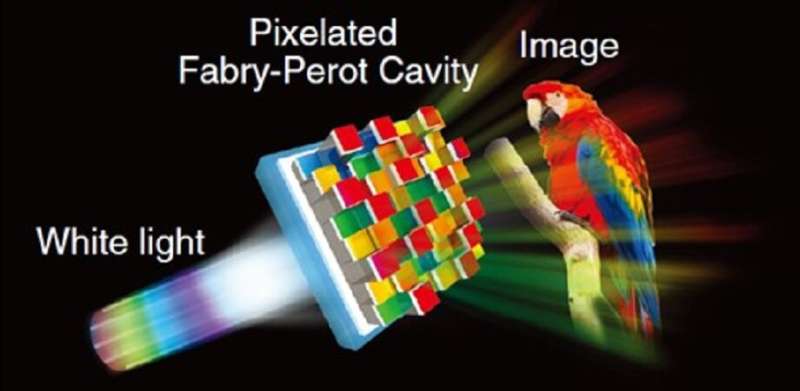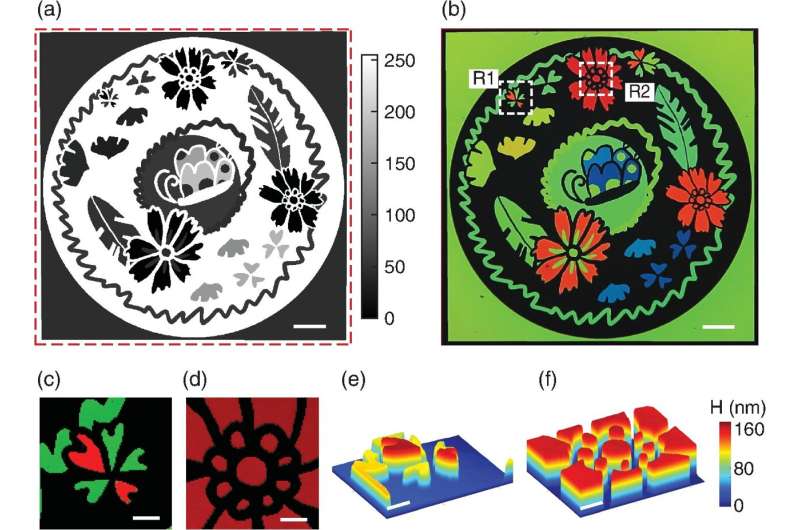Schematic diagram of the working principle of the color printing using pixelated F–P cavities. Credit: Advanced Photonics Nexus (2022). DOI: 10.1117/1.APN.1.2.026002
Structural colors result from interactions between light and nanostructures. Engineering structural colors is a promising, rapidly emerging research field. Compared with conventional painting technology using chemical dyes, structural color has a broader range of technological applications for color management. Thanks in part to its excellent durability, structural color offers an environmentally friendly route for color printing.
When color management requires a high spectral resolution or a controllable spectral bandwidth, photonic device designs rely on various physical mechanisms such as multilayer interference, diffraction, plasmonic resonance, and Fabry–Perot (F–P) cavity effects. The F–P cavity effect in particular has been attracting scientific interest. Compared with other technologies, colors generated from the F–P cavity usually have less crosstalk, greater clarity.
For color-printing applications, both reflection- and transmission-type F–P cavities with spatially variant spacer thickness have been widely investigated. The fabrication of pixelated F–P cavities has mainly relied on electron beam lithography (EBL) and related processes.
The EBL-based technique has a high spatial resolution but the fabrication process is usually time-consuming, so most of the reported sample sizes are super tiny—at the submillimeter scale. Fast manufacture of large-area F–P type color-printing devices with a high spatial resolution remains challenging.
Centimeter-scale color printing with pixelated F–P cavities. (a) The grayscale figure is obtained from the original drawing. (b) The white balanced photo of the centimeter scale color printing device. (c), (d) Microscope images of regions R1 and R2. (e), (f) 3D profiles of the regions R1 and R2, which are measured using a white light interferometer. Scale bars in (a) and (b) are 1 mm. Scale bars in (c)–(f) are 200 μm. Credit: Advanced Photonics Nexus (2022). DOI: 10.1117/1.APN.1.2.026002
As reported in Advanced Photonics Nexus, researchers from Southern University of Science and Technology (SUSTech) in Shenzhen recently developed a method to achieve centimeter-scale color printing using grayscale lithography. The colorful image with multiple color components is first converted to a predefined grayscale pattern and then engraved on the photoresist layer by controlling the exposure dose during the grayscale laser writing process.
Pixelated photoresist spacer layers are sandwiched by two semitransparent sliver thin films to form the F–P cavities. The transmission color can be continuously tuned in the visible spectral regime by finely controlling the thickness of the photoresist layer. In the visible regime, the transmission efficiency of the fabricated F–P cavities is between 39% and 50%. The pixelated F–P cavity in transmission mode is also an excellent candidate for making color filter arrays, which can be used for spectral imaging.
The newly developed laser grayscale lithography process reportedly leverages the fabrication speed and the spatial resolution of pixelated F–P cavities. According to the corresponding author, Professor Guixin Li, "The proposed large area color printing device may have great potential in practical applications such as color displays, hyperspectral imaging, advanced painting."
More information: Yu Chen et al, Centimeter scale color printing with grayscale lithography, Advanced Photonics Nexus (2022). DOI: 10.1117/1.APN.1.2.026002
Provided by SPIE

























